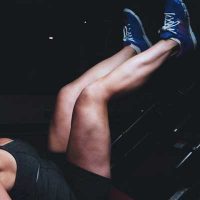The primary function of the knee is to bend and straighten the leg, to allow for a smooth gait during walking and running and to allow for jumping. It is very common to develop knee pain in both new and seasoned exercisers. Often the type of pain which develops is related to the type of exercise being done.
To understand knee pain, it is helpful to have a basic understanding of knee anatomy.
The knee joint can be divided into intra-articular and extra-articular compartments.
Intra-articular – structure inside the knee joint
Extra-articular – everything else
The knee joint is where the surfaces of the leg bones meet and interact. In order for the bones to move smoothly against each other and to provide additional stability, there is articular cartilage or cushioning shock absorber called the meniscus on both sides of the knee joint. There are also many important ligaments which connect one bone to another and provide stability. In addition, there are fluid filled sacs called bursae which allow for separation between solid tissues so that smooth movement can occur.
To help visualize the components of the knee, let’s break it down into 3 parts.
- The anterior (front) of the knee
- Knee cap or patella
- Quadriceps tendon
- The medial aspect (side) of the knee closest to the other knee
- Medial meniscus (cushion)
- Medial part of the joint capsule (the whole joint capsule encloses the entire knee)
- Medial Ligaments (provide stability for the knee and connect bone to bone)
- The Lateral aspect (outer) part of the knee
- Lateral part of joint capsule
- Lateral meniscus
- Lateral ligaments
The knee is actually more complex then described above and does have the ability for rotation in addition to bending and straightening and other components not described above. For the purpose of this article, we will focus on basic knee motions and components.
Now that we have a basic understand of the knee, let’s focus on what can go wrong with the knee.
In general, knee pain can be caused by:
- Injuries due to trauma
- Overuse injuries due to
- Body misalignment
- Muscle imbalances
- Degenerative conditions
- Injuries in the hips or feet
Patellofemoral syndrome (Anterior knee pain – front of the knee)
Common in new exerciser, especially runners and jumpers. This is usually due to irritation between the patella (knee cap) and femur (thigh bone). This pain can occur with increased jumping, squatting, running and climbing stairs. Usually pain occurs if there is repeated stress on the knee or if there is a sudden significant increase in physical activity. It is often treated with rest, ice, elevation and compression (RICE) and specific exercises to strengthen muscles surrounding the knee, and core.
Structural Injuries
Knee injury can also result from structural changes or damage such as a dislocation, slippage or tears of the menisci or ligaments surrounding the knee.
Meniscal Injuries – The meniscus serves as a shock absorber for the joint. Injuries of the meniscus can be the result of a twisting injury and can cause considerable pain, joint swelling, difficulty with stairs and the sensation of locking of the knee. Occasionally the pain in the joint due to meniscal injuries will cause the brain to “shut off” the quadriceps at the knee causing the knee to “give way”.
Ligament Injuries – Ligament tears, such as a tear of the ACL (anterior cruciate ligament) can occur with a twisting injury and results in knee instability and may require surgical intervention depending on the degree of the tear. It is common to sense a “pop” and immediate leg instability with this injury. If surgery is used to repair the ACL, recovery is long and only low impact exercises are recommended initially to strengthen the muscles around the joint. In contrast, PCL (posterior cruciate ligament) tears often can be treated non surgically with physical therapy and if indicated bracing. When ligaments are torn or lax (loosened) it is common to have the sensation of poor balance or joint instability.
Tendon Injuries – Tendons are tissues that connect muscle to bone. Typically, complete tendon ruptures are abrupt and result in the inability to move the joint. The quadriceps tendon is quite large and a significant amount of degeneration must be present for it to rupture. More often this injury is the result of a high force injury. A completely torn tendon requires surgical intervention, but a partially torn one, will likely heal with immobilization followed by physical therapy.
Overuse injuries
Overuse injuries such as bursitis (inflammation of bursae), tendonitis (inflammation of the tendons), muscle strains, and Iliotibial band syndrome are usually the result of repetitive stress on a muscle, tendon or bursa. Usually there is a component of body malalignment, muscle strength imbalance, improper shoe wear, or poor form which leads to the development of these conditions. Treatment may include RICE (rest, ice, elevation, and compression) along with a detailed musculoskeletal exam to determine the etiology of the injury. This will allow for a proper treatment plan to prevent recurrence.
Arthritis
Arthritis can be divided into Osteoarthritis (wear and tear), Rheumatoid (immune mediated), Gout (due to gout crystal build up) and Septic (due to infections). Arthritis may be the result of poor diet or gluten sensitivity in some individuals. While some forms of arthritis are genetic, diet modifications, weight loss, proper shoe wear and exercise may help to offset the severity of these conditions.

